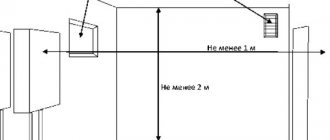Here you will learn:
- Regulatory documents for replacement
- Restrictions on the installation of gas equipment
- Is it possible to replace a gas boiler yourself?
- Procedure for replacing an outdated boiler
- Dismantling and installation of equipment
- Fines for changing independently without approval
During operation of the boiler, its power and efficiency level gradually decrease. The equipment is becoming outdated and no longer meets modern standards.
The most common reasons for replacing equipment:
- The boiler performance is no longer satisfactory. If you made an extension or connected additional devices to the circuit (for example, a boiler), then the old unit may not be able to handle the load.
- Inappropriate functionality. Installing a double-circuit device instead of a single-circuit one allows you not only to heat the room, but also to use hot water supply (DHW).
- Questions of rationality. Standard boilers consume a lot of gas. But more modern condensing devices use not only gas, but also steam. This approach increases efficiency by 110%.
- Wear or breakdown of equipment.
Therefore, if your old “AOGV” is working “on its last breath”, if the cost of maintenance is equal to the purchase of a new device, then a replacement is simply necessary.
What designs does the market offer:
- With a closed combustion chamber. This is a safer variety because the burner is closed from external influences. Smoke removal occurs thanks to a fan. The connected coaxial chimney contains two tubes through which air enters and fumes are removed. Requires a network connection.
- With open camera. An open burner requires air to be drawn from the room to maintain the flame. Good ventilation and connection to the flue shaft are required.
Regulatory documents for replacement
Gas heating equipment, if improperly installed, operated or maintained, is a source of danger. Therefore, replacing it is not just the purchase and installation of the required unit, but an entire procedure that is regulated by a number of documents.
All necessary information about replacing gas boilers is freely available. But sometimes it’s not easy to find them, since the topic of gas equipment is regulated by dozens of domestic specialized documents. These include laws, SNiPs based on them, government regulations, etc.
But among them there are a number of documents that are more important to the consumer than all the others. Since the information contained in them will help you understand the nuances of replacing stakes, as well as protect your interests from possible incorrect actions of city gas representatives.
Replacing a gas boiler is a carefully regulated procedure that requires certain knowledge. As a result, there are many requirements and rules that must be strictly followed.
The most requested documents include:
- SNiP 2.04.08-87, which is called “Gas supply”;
- SNiP 42-41-2002 entitled “Gas distribution systems”.
- State Russian Federation dated December 29, 2004 No. 190-FZ (Town Planning Code of the Russian Federation);
- RF PP dated December 30, 2013 No. 1314 (Resolution of the Government of the Russian Federation “On amendments to the rules for connecting ... to gas distribution networks”);
- RF PP dated November 16, 2016 No. 1203 (Resolution of the Government of the Russian Federation “On approval of the rules for connecting ... to gas distribution networks”);
- SNiP II-35-76, which specifies the procedure for connecting boilers;
- Code of Administrative Offenses of the Russian Federation dated December 30, 2001 N 195-FZ (Code of Laws on Administrative Offences).
Please remember that, if necessary, you should use their latest versions, which contain current articles with the latest changes and additions.
Gas boiler installation standards
There are strict rules for replacing a gas boiler in a private house, which must be observed when carrying out work:
- more than 4 m2 of area must be allocated for installation;
- the width of the entrance door must exceed 80 cm;
- you need to choose bright rooms, the window area is calculated based on the standard of 0.3 m2 per 10 m3 of volume;
- ceiling height – from 2.5 m;
- it is necessary to have a pipeline with cold liquid;
- the cross-section of the chimney must correspond to the power of the gas boiler;
- It is desirable that the wall panels are level.
Based on these rules, the most appropriate solution seems to be to install a wall-mounted boiler in the kitchen of the house. This room has all the conditions for it, and, thanks to its small dimensions, it can be hidden in a closet. But it is better to install a floor-standing gas boiler in a separate boiler room.
Requirements for free-standing combustion chambers
Separate boiler houses are built for powerful heat generators, the operation of which requires an enhanced safety regime.
Requirements for furnaces built separately from a residential building:
The premises are equipped with concrete floors or covered with fireproof finishing. For equipment weighing over 200 kg, a reinforced base with a height of 15 cm is prepared.
Heated water enters the house through an insulated pipeline with low heat loss. A free-standing furnace does not take up the usable space of the house, is safe to use and does not disturb the architectural appearance of the building. Can be used for heating a group of buildings, for example, a house, a bathhouse and a greenhouse.
Requirements for doors
Two types of doors are used in furnace rooms:
- external without reinforcement for access to the street;
- internal fire protection for communication with residential premises.
External doors should be easy to break off their hinges in the event of an explosion. Then the energy will be directed outward and cause less destruction than with a rigidly and firmly fixed canvas. But in any case, you need to protect the premises from strangers who could enter and damage expensive equipment.
Interior doors are designed to contain flames in a fire for 15 minutes. Type 3 fabrics with a fire resistance limit of EI 15 comply with the standard. They retain their integrity and thermal insulation properties for a period of time sufficient for the evacuation of people from the house and the arrival of rescue services.
Is it possible to replace a gas boiler yourself?
According to current requirements, replacing a gas boiler is equivalent to redevelopment, so it is necessary to go through the full re-registration process. However, the legality of the change depends on which new boiler unit you are replacing the old one with:
- when replacing with a similar gas boiler of the same manufacturer, the same model and power, there is no need for approval, and you can dismantle the old one and install a new boiler yourself;
- when replacing with one of similar power, but of a different model, it is officially required to obtain an agreement and draw up a new project, since it contains unique serial and serial numbers of the boiler; due to other characteristics, changes in the heating system may be required. However, some owners still change equipment without permission, counting on the fact that verification often pays attention only to power. In rare cases, a fine is paid and a replacement is legalized.
In all other cases: when changing to another model of a different power, floor-standing to wall-mounted, including when replacing with a more powerful one, even of a similar model, you need to go through the entire process of coordination and connection.
This is somewhat easier to do, since the heating system is already assembled, and changes to the piping or wiring are usually not required. You can dismantle the old boiler and install a new one on your own, but you must call certified specialists to connect to the gas main and initial start-up, otherwise the warranty on the equipment will be invalid.
To change a gas boiler to an electric one, you only need to submit an application for disconnection from the gas main. Electric boilers with a power of over 10 kW require simpler approval from local Energy Supervision services.
Cost of specialist work
Prices for a full replacement, paperwork and commissioning work depend on the type and model of the boiler, region and company providing the services. In Moscow and the Moscow region it is about 8-22 thousand rubles, for St. Petersburg – 6-15 thousand rubles, for the regions – 4.5-12 thousand rubles. About half of the cost is for dismantling the old and installing a new boiler unit, almost half is for commissioning.
Please note that the required paperwork process is not always included in replacement services.
Cost of specialist work
Before replacing the boiler, you need to prepare a package of documents and set aside a certain amount of money to pay specialists for gasification of houses.
For the capital of Russia and the Moscow Region, the costs will be about 8,000 - 22,000 rubles, for St. Petersburg - 6 - 15 thousand rubles, for the regions - 4,500 - 12,000 rubles. The indicated amounts are given taking into account the removal of the old device, installation of a new one and various adjustment work.
Procedure for replacing an outdated boiler
Gas equipment is considered a high-risk device.
Therefore, all work on installation and maintenance of gas appliances is also considered work with increased danger. The existing rules clearly answer the question - how to replace a gas boiler in a private house - it is prohibited to install or replace boiler equipment yourself. Only special bodies (gorgaz, raygaz, oblgaz) through enterprises that have a license for such work have the right to install boilers.
To begin replacing the boiler, you need to do the following:
- Write an application to the gas service to obtain permission to replace the boiler. You need to know that when replacing an old boiler with a similar one, you do not need to create a new project, but if changes occur - a boiler of a different type, the location or gas supply diagram changes, then a new project is created.
- After receiving the answer, you need to submit the construction passport to the gas service. Collect and submit DVK inspection reports, and if an imported boiler is being installed, a certificate of conformity.
What documents are needed when replacing a gas boiler?
Before replacing a gas boiler, it is necessary to collect many documents and obtain permission to carry out such work.
You will need the following documents:
- If the equipment is from foreign manufacturers, then you need to provide a certificate of compliance with our safety standards;
- If the boiler is double-circuit, then it is necessary to have a sanitary and hygienic certificate to supply hot water for domestic needs. Typically, such a document is provided immediately along with the warranty card;
- Document on inspection of ventilation and smoke ducts;
- Warranty agreement for at least 1 year, which is concluded with a service company;
- A document with the results of connecting equipment to utility networks.
- Act on hidden work when installing a coaxial chimney through the wall;
- Project with changes. The main condition: the new boiler must be legal.
You are responsible for collecting all documents yourself. If you do not have this opportunity, then you can contact a special installation company. But in this case it is necessary to calculate additional costs.
Is a new project needed when replacing a gas boiler?
The project specifies the model, type and power of the heating unit. In addition, each boiler has its own serial number, indicated in the technical passport and included in the project documentation. Therefore, when replacing, you will need to make a new project indicating new data.
You must go through the following registration steps again:
- Obtain technical specifications for replacing a gas boiler. At this stage, the gas distribution company can change the performance of the unit based on the actual living area of the house.
- Make a new project.
- Obtain approval by providing a gas distribution project, technical specifications, and the results of checking the chimney duct.
- Replace the old unit with a new one.
When replacing an old gas boiler with a new one, the following documents are needed:
- Passport.
- Documents of the owner of the residential premises.
- Technical passport for gas equipment.
- Technical conditions.
Standard prices for replacing already installed gas equipment are 1000-1500 rubles, depending on the region.
Features of replacing a boiler of the same power
If the gas consumption per hour of the new boiler is similar to the gas consumption of the old one, then this greatly simplifies the task. Since all the owner needs to do is submit a notification to Gorgaz about the replacement completed.
And to it should be attached:
- Boiler connection certificate.
- Inspection report for ventilation and chimney.
- Agreement for at least one year of maintenance of gas equipment.
After reviewing the application, permission is given. After which the equipment is replaced, tested and its operation begins. Thus, RF PP No. 1203, clause 61(1) allows to act.
Is it possible to replace a gas boiler with an electric one?
Replacement is quite possible, but for this you will have to obtain permission from another organization involved in electricity supply. Documents are needed only if the electric boiler has a power of more than 8 kW. Up to this performance limit, the unit belongs to ordinary household water heating devices of the boiler type, therefore, it is installed without permits or approvals.
For productive electric boilers, a separate power supply line will be required. You will need to make a project and obtain permission to increase the amount of electricity allocated. Separately, you need to write a statement about disconnecting the gas boiler from the main line.
What to do in an emergency situation?
Are you still undecided whether you need to change your gas boiler and when is the best time to do it in order to meet it in the shortest possible time? But you have once again encountered a breakdown and are worried that you may be left in the cold winter without heating equipment?
To resolve the situation with replacing the boiler in winter as quickly as possible, you should contact Gorgaz. The specialists of which will deliver and install a boiler that matches the power of the old one and will draw up the necessary reports without delay. This approach will minimize negative consequences and avoid penalties.
It should be remembered that individual requirements of regional gas services may differ. Therefore, it never hurts to get the necessary advice from employees of the specified organizations
As for the total cost in such a development of events, it will turn out to be quite high - such a purchase of a boiler is not always profitable.
Therefore, if time is of the essence, it is better to choose a boiler with the same gas consumption per hour of operation with an old unit. And after installation, notify Gorgaz about this, as indicated in paragraph “Features of replacing a boiler of the same power.”
Dismantling and installation of equipment
The procedure for replacing a gas boiler in a private house involves dismantling the old unit and then installing a new one. Many people are interested in whether it is possible to replace a gas boiler themselves. In general, yes, you can do it yourself by removing the old device and installing the new one. But connecting the system to the gas main and the first start-up of the unit should only be performed by a gas specialist.
Note! Regarding self-installation, one nuance should be taken into account - some manufacturers prohibit installing their equipment with their own hands, otherwise the user will lose the warranty on their boiler. Therefore, before making a decision, it is worth weighing the pros and cons.
It is quite possible to remove the old unit yourself - this is a fairly easy process and does not carry any risk. It’s just important not to forget to perform the following sequence of actions:
- flush the heating system;
- drain the water from the unit;
- shut off gas, water and heating pipelines;
- disconnect the chimney pipe;
- remove the boiler from the wall or remove it from the floor.
Installing a new gas boiler requires certain skills, so if you are not sure that you can connect everything without errors, it is better to entrust the installation to a specialized organization. Self-installation of the device involves the following steps:
- For a wall-mounted boiler, you need to mark the wall and indicate the locations for fasteners. For the floor - prepare an appropriate foundation.
- There should be a non-flammable shield between the wall and the gas unit. The boiler should not fit closely to the wall; a gap of 20-30 cm must be taken into account.
- After installing the unit on the wall or floor, water and heating communications are connected. It is advisable to install a filter on the water supply pipe from the central water supply so that lime deposits do not clog the heat exchanger of the device. All connections of the boiler pipes and water supply and heating pipes should be sealed with a special sealant or fum tape.
- Now you should connect the boiler to a 220 V power supply and grounding. To extend the service life of the unit, it is also necessary to connect a voltage stabilizer.
- Next, connect the smoke outlet pipe to the opening of the existing chimney: for atmospheric models - with a classic chimney, for turbocharged models - with a coaxial pipe.
- After this, you need to check the tightness of the system: fill it with water and look at the pressure readings - normally they are 0.8-1.8 Bar.
- An employee of the gas supply company is invited, who must connect the unit to the gas main and make the first start-up of the boiler.
After the specialist starts the unit and checks the functionality of the system, he will issue a document authorizing the use of the equipment. If any problem arises, you will have to fix it first, and then call a specialist again to check.
If you want to minimize the time spent on obtaining permission to replace the boiler, it is better to choose a unit with characteristics similar to the old model. But this option is only suitable if there are no needs for other device parameters.
Is it possible to install it yourself?
In fact, the joint venture stipulates that installation work must be performed by a licensed and certified specialist. Few people know, but this standard applies exclusively to work on connecting to the gas main. You can connect the boiler yourself, provided you have a technical education.
When deciding to install a boiler yourself or involve specialists, several nuances are taken into account:
- When installing a condensing type boiler, you will need to connect the unit to the electrical network and connect the condensate removal system without disruption.
- Perform a number of approvals during installation. Additional approval of the chimney will be required when installing a gas heating boiler. The inspection is carried out by a representative of the gas industry “stove man”. During operation, such an audit will be carried out every year, before the heating season.
- There is no guarantee for self-installed gas equipment. Only when the connection is made by a representative of the company selling the boiler, a stamp is placed in the document indicating the start of service.
After installation, a representative of the gas industry must check the operation of the boiler and fill out commissioning documents.
Fines for changing independently without approval
Replacing a gas boiler in a private house without permission and without drawing up a project is prohibited by law - Art. 7.19 Code of Administrative Offenses of the Russian Federation “Unauthorized connection and use of electrical, thermal energy, oil or gas.” The fine ranges from 10 to 15 thousand rubles; in the event of an emergency, criminal liability is possible.
The replacement may be discovered during the next scheduled inspection: at a minimum, the boiler passport will not have a stamp indicating that specialists have carried out commissioning work. Then the gas distribution company terminates the contract, disconnects the house from the gas main, and imposes penalties.
However, in most cases, gas workers do not pay attention to the changes made or turn a blind eye even to serious violations; it is often possible to reach an agreement with the workers. Many owners of private houses, especially in rural areas, actively use loyalty, but what works today can be interrupted tomorrow, and it is impossible to legitimize an already installed gas boiler. Therefore, despite the huge bureaucracy, we recommend that you initially arrange a replacement in accordance with all the rules, especially since the process can be entrusted to specialists for relatively little money.
Heating a house 100 m²
Really, honestly, really
| Heating a house 100 m² from | RUR 49,500 |
| Installation of heating boiler | 8,000 rub. |
| Installation of heating radiators (no more than 10 pieces)!!! The cost of installing a standard (mounted, not in-floor convector) heating radiator is 4,000 rubles | 25,000 rub. |
| Radiator pipe routing | 12,000 rub. |
| Pressure testing and filling with coolant | 4,500 rub. |
| TOTAL turnkey: | RUB 49,500 |
| Drilling holes, rigging, dismantling, paid extra | according to_estimate |
Heating a house 100 m² Attention. This cost is a preliminary estimate; these prices should only be used as approximate prices. The exact cost of the work is calculated after an engineer visits the work site, its complexity, and quantity.
Cost of materials from 120,000 rubles
Included by type of work
| Boiler installation | Installing an electric boiler on a wall or floor |
| Installation of pipes without “grooving” | Open pipeline installation with wall or floor mounting |
| heating radiators | Mounting the heating device on the wall, installing fasteners |
| System pressure testing | Pressure testing of the assembled system with an air compressor to identify possible leaks |
| Commissioning works | Filling with coolant (antifreeze or water), removing air from the heating system during work |
| !!! No heated floors | It is calculated additionally, it requires coordination of the type of substrate for the pipes, the type of use of the pipe, the possibility of control and automatic control, and of course the footage |
| !!! Without external chimney | To calculate the cost, an engineer’s visit is required, an inspection of the roof structure, window location and much more. |
House heating
Heating a house 250 m² - 87,500 rub.
Really, honestly, really
| Heating of a house 250 m² from | RUB 87,500 |
| Installation of heating boiler | 8,000 rub. |
| Installation of heating radiators (no more than 20 pcs)!!! The cost of installing a standard (mounted, not in-floor convector) heating radiator is 4,000 rubles | 45,000 rub. |
| Radiator pipe routing | 30,000 rub. |
| Pressure testing and filling with coolant | 4,500 rub. |
| TOTAL turnkey: | 87,500 rub. |
| Drilling holes, rigging, dismantling, paid extra | according to_estimate |
Heating a house 250 m² Attention. This cost is a preliminary estimate; these prices should only be used as approximate prices. The exact cost of the work is calculated after an engineer visits the work site, its complexity, and quantity.
Cost of materials from 300,000 rubles
Included by type of work
| Boiler installation | Installing an electric boiler on a wall or floor |
| Installation of pipes without “grooving” | Open pipeline installation with wall or floor mounting |
| heating radiators | Mounting the heating device on the wall, installing fasteners |
| System pressure testing | Pressure testing of the assembled system with an air compressor to identify possible leaks |
| Commissioning works | Filling with coolant (antifreeze or water), removing air from the heating system during work |
| !!! No heated floors | It is calculated additionally, it requires coordination of the type of substrate for the pipes, the type of use of the pipe, the possibility of control and automatic control, and of course the footage |
| !!! Without external chimney | To calculate the cost, an engineer’s visit is required, an inspection of the roof structure, window location and much more. |
Heating a house 250 m²
8 [email protected] ROUND THE CLOCK
Russia, Moscow, ☞ Pyatnitskoe highway, 55A Russia, Moscow, Mitino, ☞ 3 Mitinsky lane, 1 (ARCHIVE) Russia, Moscow, ☞ Yana Rainis boulevard, 19, cor. 1 Russia, Moscow, ☞ Marina Raskova, 10 kor. 4 Russia, Moscow, ☞ 1st Grayvoronovsky proezd, 2A Russia, Volokolamsk, ☞ Novo-Soldatskaya street, 23с3 Russia, Golitsino, ☞ Petrovsky pr., vl 5 с 1 Russia, Elektrougli, ☞ st. Central, 50 Russia, Klin, ☞ Moskovskaya st., 31 Russia, Konakovo, ☞ Lenina, 7A Russia, Podolsk, ☞ st. Fedorova, 19 Russia, Tula region, ☞ Plavsk Russia, Chelyabinsk, ☞ Komsomolsky pr-t, 2, kor. 315 Russia, Ramensky urban district, ☞ Chulkovo village Russia, Republic of Crimea, Yalta urban district, urban settlement ☞ Beregovoye
UKOT - today
- The date of creation of the educational institution is August 31, 1936, when, in accordance with Resolution No. 1231 of the Council of People's Commissars of the RSFSR, the Bashkir Technical School of the Flour Milling Industry was organized. Two departments were created - flour milling and baking. More information about the history of the college can be found on the Bread Museum website.
- The functions and powers of the founder of the GBPOU UKOT on behalf of the Republic of Bashkortostan are carried out by the Ministry of Education of the Republic of Bashkortostan.
- The state budgetary educational institution of secondary specialized education "Ufa Mechanics and Technology College" has a perpetual License for the right to conduct educational activities
- The college has state accreditation of 12 educational programs (Certificate of state accreditation No. 0468 dated June 22, 2012)
- The college has developed and implemented a quality management system in relation to the design and implementation of educational activities in the field of secondary vocational education in accordance with GOST ISO 9001: 2008; On July 18, 2012, a Certificate of Conformity was received Registration No. ROSS RU FK68 K00031.
- The mission of the college within the framework of the quality policy is to train competent specialists at the level of international and national standards in accordance with the requirements of employers who are competitive in the labor market and have high civic and moral qualities.
- The college also provides training in 13 accredited specialties and 13 additional education programs (preparation for admission to secondary school, the course “Love the art of confectionery”, advanced training in the profile of the college’s main professional educational programs, etc.).
- The college has 3 classrooms for coursework and diploma design, standard laboratories for chemical disciplines, a commodity science laboratory with a full set of necessary equipment; locksmith workshops; training and production bakery (certified with the right to sell finished products), consisting of 2 workshops (baking and confectionery), sports and gyms, sports ground, assembly hall, canteen, first-aid post, dental office, educational and auxiliary and storage facilities, vehicles , library, reading room, Bread Museum.
- SBPOU UKOT is constantly developing - opening promising specialties, expanding and modernizing teaching and laboratory facilities, introducing new technologies, and looking for productive ways of development.
Administration of Yemanzhelinsky urban settlement
- Boris Dubrovsky congratulated the residents of Varna on the 175th anniversary of the village 07/18/2018
- Boris Dubrovsky discussed with the investor the implementation of a special investment project to develop a gold deposit 07/17/2018
- In the Chelyabinsk region, the second stage of issuing land plots to large families in the village of Severny has begun 07/16/2018
- Lending volumes to small and medium-sized businesses in the Chelyabinsk region increased by a third 07/18/2018
- Construction of a bypass canal on Sak-Elge began in the Karabash district 07/18/2018
- Repair work was completed at the House of Culture in the village of Yemanzhelinka 07/18/2018
Description
Izolon is a polyethylene foam whose structure consists of cells. This material is distinguished by elasticity and softness and porosity of the structure. The material is pleasant to the touch and easily takes the desired shape. There are two types - stitched and unstitched, each of which has its own characteristics.
Waterproof and durable base is UV and chemical resistant. Keeps its shape from -75 to +75 degrees. There are several types of isolon, with and without a layer of foil. It is white isolon that is used to make lamps.
Heating a house 200 m² - 72,500 rub.
Really, honestly, really
| Heating a house 200 m² from | RUB 72,500 |
| Installation of heating boiler | 8,000 rub. |
| Installation of heating radiators (no more than 15 pieces)!!! The cost of installing a standard (mounted, not in-floor convector) heating radiator is 4,000 rubles | 35,000 rub. |
| Radiator pipe routing | 25,000 rub. |
| Pressure testing and filling with coolant | 4,500 rub. |
| TOTAL turnkey: | RUB 72,500. |
| Drilling holes, rigging, dismantling, paid extra | according to_estimate |
Heating a house 200 m² Attention. This cost is a preliminary estimate; these prices should only be used as approximate prices. The exact cost of the work is calculated after an engineer visits the work site, its complexity, and quantity.
Cost of materials from 250,000 rubles
Detailed estimate for installation of heating system
Included by type of work
| Boiler installation | Installing an electric boiler on a wall or floor |
| Installation of pipes without “grooving” | Open pipeline installation with wall or floor mounting |
| heating radiators | Mounting the heating device on the wall, installing fasteners |
| System pressure testing | Pressure testing of the assembled system with an air compressor to identify possible leaks |
| Commissioning works | Filling with coolant (antifreeze or water), removing air from the heating system during work |
| !!! No heated floors | It is calculated additionally, it requires coordination of the type of substrate for the pipes, the type of use of the pipe, the possibility of control and automatic control, and of course the footage |
| !!! Without external chimney | To calculate the cost, an engineer’s visit is required, an inspection of the roof structure, window location and much more. |
Heating a house 150 m² - 52,500 rub.
Really, honestly, really
| Heating of a house 150 m² from | RUB 52,500 |
| Installation of heating boiler | 8,000 rub. |
| Installation of heating radiators (no more than 10 pieces)!!! The cost of installing a standard (mounted, not in-floor convector) heating radiator is 4,000 rubles | 25,000 rub. |
| Radiator pipe routing | 15,000 rub. |
| Pressure testing and filling with coolant | 4,500 rub. |
| TOTAL turnkey: | RUB 52,500 |
| Drilling holes, rigging, dismantling, paid extra | according to_estimate |
Heating a house 150 m² Attention. This cost is a preliminary estimate; these prices should only be used as approximate prices. The exact cost of the work is calculated after an engineer visits the work site, its complexity, and quantity.
Cost of materials from 200,000 rubles
Included by type of work
| Boiler installation | Installing an electric boiler on a wall or floor |
| Installation of pipes without “grooving” | Open pipeline installation with wall or floor mounting |
| heating radiators | Mounting the heating device on the wall, installing fasteners |
| System pressure testing | Pressure testing of the assembled system with an air compressor to identify possible leaks |
| Commissioning works | Filling with coolant (antifreeze or water), removing air from the heating system during work |
| !!! No heated floors | It is calculated additionally, it requires coordination of the type of substrate for the pipes, the type of use of the pipe, the possibility of control and automatic control, and of course the footage |
| !!! Without external chimney | To calculate the cost, an engineer’s visit is required, an inspection of the roof structure, window location and much more. |
House heating










